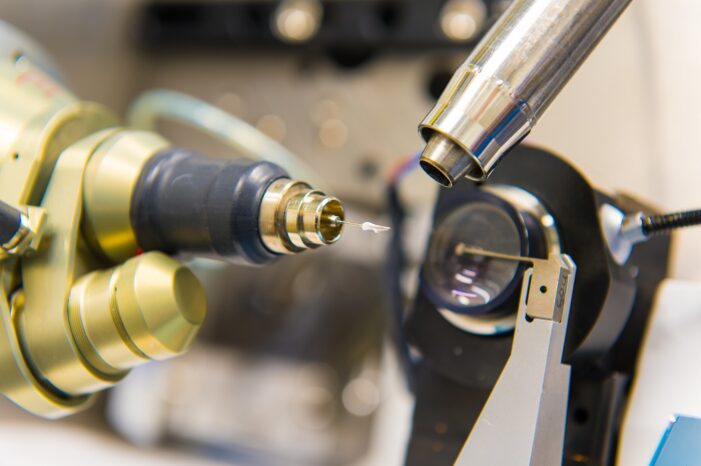Lessening X-ray Damage Speeds Protein Discovery
07/17/2013

Protein crystal samples are placed on a small metal tip so X-rays from the adjacent beam pipe can pass through them and diffract off the atoms inside the crystal. Computers help scientists interpret the scattered light patterns recorded by detectors to create a picture of the position of atoms inside the crystal. [Image courtesy of The Argonne National Laboratory.]
Synchrotron facilities like the DOE’s Advanced Photon Source (APS) at Argonne contain particle accelerator systems designed to produce extraordinarily bright and high-energy X-ray beams. At these facilities, scientists can peer deeply into the atomic structure of molecules using the method of X-ray crystallography.
However, the use of powerful X-ray beams to study protein crystals poses a dilemma: the beams provide the best tool for understanding a protein’s structure and biological function, but they often damage the crystal.
Scientists examined three different X-ray-based methods for solving protein structures and recommended one called “submicrometer line focusing” as the most promising for easing the dilemma. The beam strikes the protein crystal with an area smaller than a micrometer, thereby minimizing the impact area. The beam is also focused as a vertical line, delivering a more concentrated dose of X-rays per area. The researchers also suggested using a new lens they designed that breaks the powerful beam into many mini-beams, spaced far enough apart that the damage one mini-beam creates lies outside the area probed by neighboring mini-beams.
Funding Acknowledgements
Midwest Center for Structural Genomics (MCSG) and Structural Biology Center (SBC) at Argonne National Laboratory (ANL): support. Funding in part: grant from National Institutes of Health (NIH; GM094585) and by the Office of Biological and Environmental Research (OBER), U.S. Department of Energy (DOE) Office of Science, under Contract DE-AC02-06CH11357. Submitted manuscript created by University of Chicago Argonne, LLC, operator of ANL, a DOE Office of Science Laboratory, is operated under Contract No. DE-AC02-06CH11357.
Related Links
- BER Resource: Structural Biology Center
- Feature Story: Lessening X-ray damage is healthy for protein discovery data too
References
Finfrock, Y. Z., Stern, E. A., Alkire, R. W., Kas, J. J., Evans-Lutterodt, K., Stein, A., Duke, N., Lazarski, K. & Joachimiak, A. (2013). Acta Cryst. D69, 1463-1469. [DOI: 10.1107/S0907444913009335]
